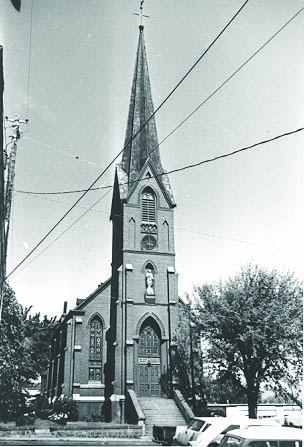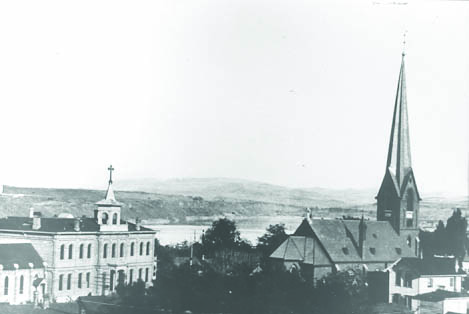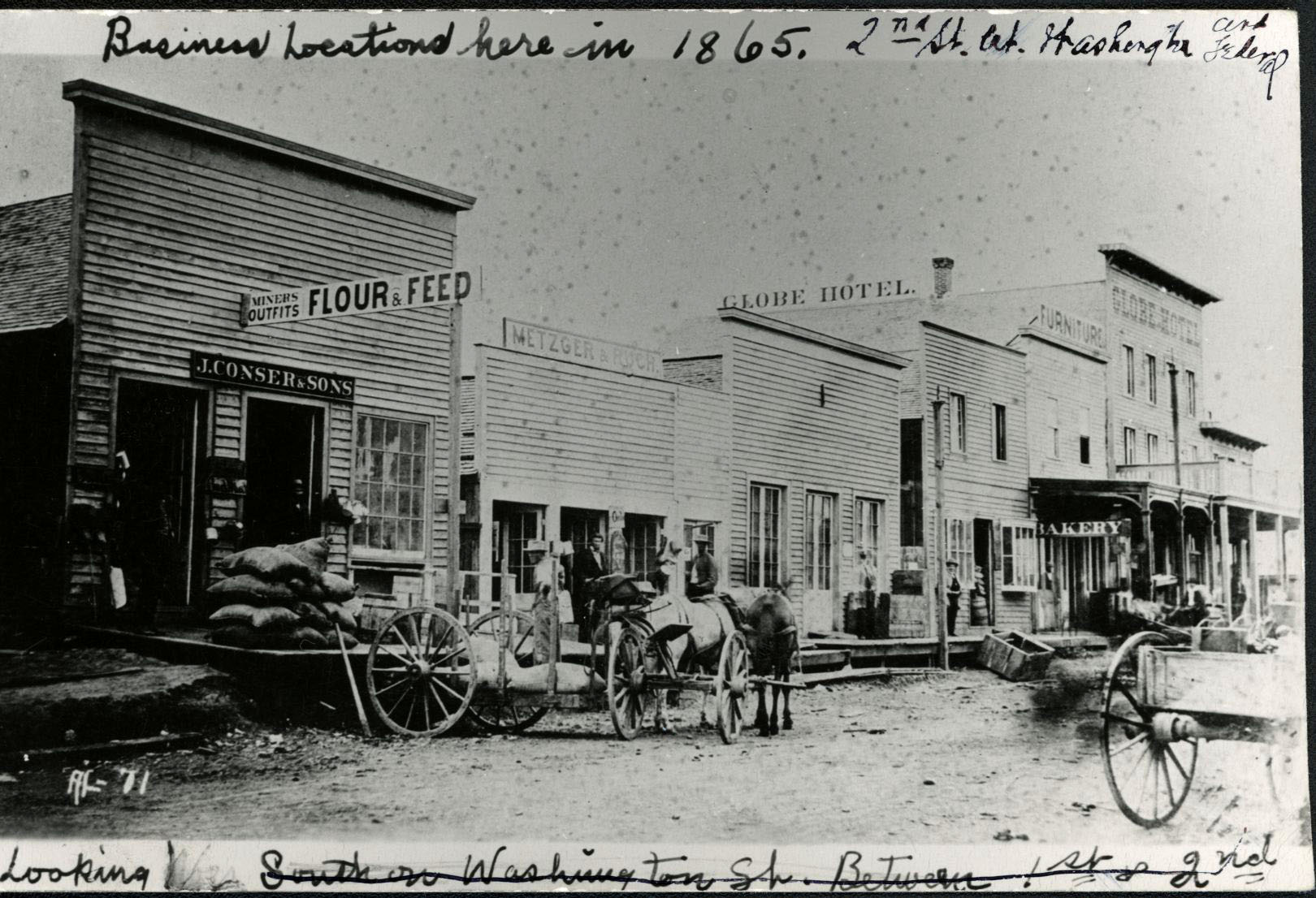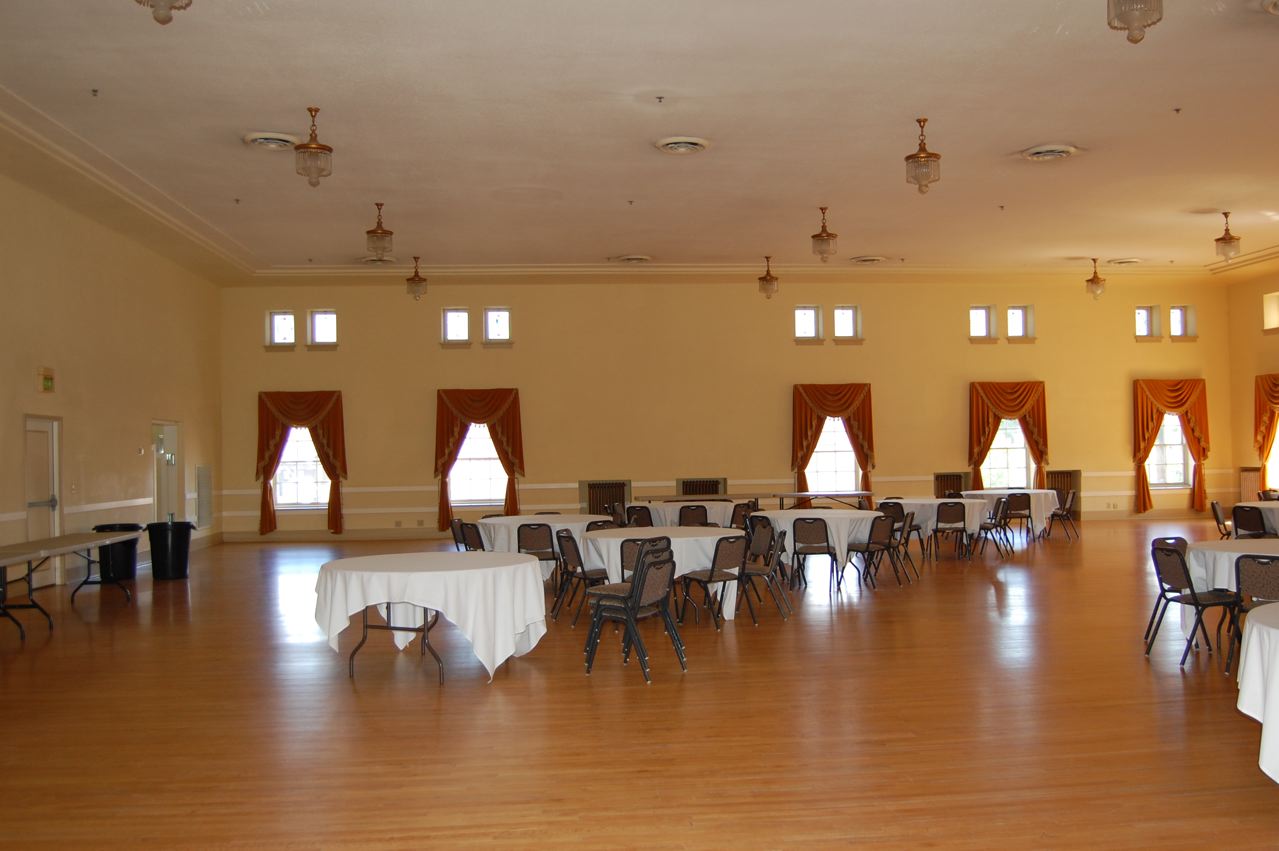Old St. Peter’s Landmark, a former Roman Catholic church located at the corner of Third and Lincoln Streets, has been a distinctive feature in The Dalles since its completion in 1898. In its early years, steamboat captains on the Columbia River and surveyors used the church’s steeple as a navigational tool or benchmark.
Old St. Peter’s was the fourth Catholic church in The Dalles, replacing a building that was constructed in 1861. By 1890, the building was deteriorating, and a parish committee—comprised of Max Vogt, Henry Herbring, E.P. Fitzgerald, and Jacob Fritz—was created to plan for the construction of a new building to serve the growing congregation.
On June 17, 1891, the old church was moved to the rear of the lot to make way for new construction, which fire, flood, and an economic slump delayed until 1897. The architectural plan, which was obtained from Herr Rinklage of Munster, Westphalia, Germany, was modified by Portland architect Otto Kleeman.
The cornerstone was laid and blessed by Archbishop William Hickley Gross on July 25, 1897, and the church was dedicated on March 17, 1898. At the time, it was considered the finest church in the archdiocese and was a source of community pride.
Old St. Peter’s, measuring 120 by 40 feet, is oriented with its façade to the east and its apse to the west. Built in the Gothic Revival style, the church is constructed of red brick masonry with a steeple rising from a louvered belfry to a height of 176 feet. The belfry contains a 533-pound bell (1866), salvaged from the earlier church.
The steeple is surmounted by a six-foot cross and a rooster weathervane crafted by Frank S. Gunning. The rooster is a symbol of St. Peter, a reference to the episode in which he denied Christ three times before the cock crowed. The roof was galvanized iron Spanish tile; it was replaced in 1995 with tile designed in Canada to match the original. Lion heads decorate the downspouts of the steeple, and a statue of St. Peter occupies a niche over the main portal.
The interior of Old St. Peter’s features a rib-vaulted ceiling, about forty feet at its highest point, supported by iron columns. The unusual tin ceiling cover is embossed with floral designs in an overall diaper pattern. The interior also features forty stained-glass windows, six rose windows, and seventeen pairs of lancets, made by the Povey Brothers of Portland. Many of the windows were given in memory of pioneer families. The cherubs in four of the rose windows are reputedly portraits of David Povey’s daughters.
Painted portrait medallions and other wall and ceiling decorations were added to the interior in 1954-1955 by Theodore Braash, a German artist. The chancel railing and altars of Carrara marble were also later additions. The wooden pews feature a hand-carved leaf and ivy motif with pearl trim and spring-loaded hat holders. A statue of the Virgin Mary was carved from the keel of a ship that wrecked off the coast of San Francisco in the early 1850s. It was a gift from the Vogt and Chapman families in memory of a relative saved from the shipwreck.
There are three historic organs: an upright pump organ first installed in the earlier church in 1866 and used at Old St. Peter’s until 1925; a 1907 Kilgen pipe organ, made of tigerwood with twenty-six visible pipes, installed and dedicated in 1925; and a collapsible pump organ from about 1880, which was originally used by Father Bronsgeest as he traveled from parish to parish in the area.
Old St. Peter’s served as a place of worship until 1968, when the congregation moved to a new building, leaving behind the structure and all of its furnishings. The building was saved from demolition in 1971 by a group of people who formed Old St. Peter’s Landmark Preservation, Inc., which was instrumental in securing its placement on the National Register of Historic Places in 1974. The organization now maintains the building as a museum and as a site for weddings and other cultural events, using the income generated for preservation and repair work.
-
![Old St. Peter's]()
Old St. Peter's.
Old St. Peter's Courtesy Oreg. Hist. Soc. Research Lib.
-
![Old St. Peter's]()
Old St. Peter's .
Old St. Peter's Courtesy Oreg. Hist. Soc. Research Lib.
Related Entries
-
![The Dalles]()
The Dalles
The Dalles is one of the oldest permanently occupied places in Oregon, …
-
![The Dalles Civic Auditorium and Veterans Memorial]()
The Dalles Civic Auditorium and Veterans Memorial
On April 7, 1922, four years after the armistice ended World War I, an …
Map This on the Oregon History WayFinder
The Oregon History Wayfinder is an interactive map that identifies significant places, people, and events in Oregon history.
Further Reading
“Official Website for Old St. Peter’s Landmark.” http://www.oldstpeterslandmark.org/
Barclay, Melissa. “Povey Brothers Revisted.” Stained Glass Quarterly (Winter 2003): 294-299.
Harwig, Paul B. “St. Peter’s Roman Catholic Church.” Nomination Form for the National Register of Historic Places (1973):




